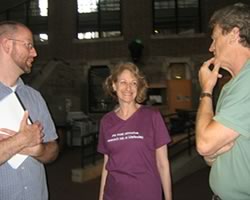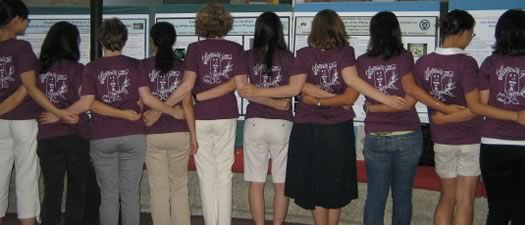Overview
 My research involves the application of multinuclear Magnetic Resonance spectroscopy and imaging to problems in biology and medicine. The projects range from the development of a multi-functional MRI-detectable nanoparticle for cancer treatment (in collaboration with Professors Nolan Flynn of the Chemistry Department and Andrew Webb of the Biological Sciences Department) to the study of neural development in mice and crustaceans using micro-MRI and in vivo 1H MR spectroscopy (in collaboration with Professors Barbara Beltz of the Neuroscience Program and Joanne Berger-Sweeney of Tufts University). In the past, my medical work was in the field of ophthalmology and focused on eye diseases such as uveal melanoma and diabetic retinopathy, and on the physiology of aqueous humor production; I have also collaborated for many years on studies of the metabolic properties of cyanobacteria.
My research involves the application of multinuclear Magnetic Resonance spectroscopy and imaging to problems in biology and medicine. The projects range from the development of a multi-functional MRI-detectable nanoparticle for cancer treatment (in collaboration with Professors Nolan Flynn of the Chemistry Department and Andrew Webb of the Biological Sciences Department) to the study of neural development in mice and crustaceans using micro-MRI and in vivo 1H MR spectroscopy (in collaboration with Professors Barbara Beltz of the Neuroscience Program and Joanne Berger-Sweeney of Tufts University). In the past, my medical work was in the field of ophthalmology and focused on eye diseases such as uveal melanoma and diabetic retinopathy, and on the physiology of aqueous humor production; I have also collaborated for many years on studies of the metabolic properties of cyanobacteria.
NMR spectroscopy and imaging are extremely sensitive to the physical environment of nuclei such as protons, nitrogen, sodium or phosphorus. NMR spectroscopy enables us to study the structures of complex biological molecules in solution, the concentration of neural metabolites in the brain, or the phosphate metabolism of organisms. MRI is based on the behavior of water protons in animals or humans and enables us to perform static or dynamic studies of these organisms. All magnetic resonance studies are carried out at the NMR/micro-MRI Facility at Wellesley College.
Over the years my research students have been equal partners in my projects. Students have been co-authors on many of my publications and have presented their work at local, national and international scientific meetings. The type of project in which a student becomes involved depends upon her interests, but there are opportunities in every area described on this website.
Student Research Projects
Interdisciplinary research opportunities in Magnetic Resonance Imaging (MRI) and Magnetic Resonance Spectroscopy (MRS) are available to students at Wellesley thanks to a grant from the National Science Foundation. At our micro-MR imaging facility, several projects are underway using proton MRI and in vivo MRS at 9.4 T. (See recent publications listed on this website.)

CANCER RESEARCH
A new project in collaboration with Professors Nolan Flynn of the Chemistry Department and Andrew Webb of the Biological Sciences Department seeks to develop a gold nanoparticle with an SPIO core (FexOy-AuNP) that will be targeted toward particular cancer cells and suitable for boron neutron capture therapy (BNCT). Our in vivo model employs the chorioallantoic membrane of chicken or quail eggs as a substrate for the growth of human pancreas and colon tumor xenografts. We plan to track the biodistribution of the FexOy-AuNPs and detect whether the coupled monoclonal antibody has preferentially targeted the xenograft tumors. We also plan perform BNCT through thermal neutron irradiation.
MRI STUDIES IN NEUROSCIENCE
In collaboration with Professor Barbara Beltz of the Neuroscience Program, we have undertaken studies of the source of stem cells in the neurogenic niche of a crayfish, Procambarus clarkia. To do this we culture crayfish blood cells, introduce fluorescently tagged superparamagnetic iron oxide particles (SPIOs) into the cells, and use fluorescent and confocal microscopy, as well as MRI, to determine whether the cells have incorporated the SPIOs. We then introduce the SPIO-labeled HSCs into a crayfish and track them from the blood stream into the brain using MRI.
In collaboration with Professor Joanne Berger-Sweeney of the Tufts University, both MRI and MRS techniques are being used to study brain development in mouse models for Rett Syndrome (RTT), a neurodevelopmental disorder of 1/10,000 girls, and schizophrenia, affecting approximately 1.5 million people in the U.S. Mutations of the Mecp2 gene, an X-linked gene coding for the transcriptional repressor protein MeCP2, leads to RTT in humans. Our mouse models of RTT are based on the modification or deletion of a portion of the Mecp2 gene. We acquire and analyze MR images and in vivo and ex vivo spectra of the brains of both female heterozygous (Het) and male null (Null) mice. We have examined the effect on MR images and spectra of potential treatments for RTT such as environmental enrichment and choline administration. Our mouse model for schizophrenia involves a knockout of the GCPII gene. We use similar MRI and MRS studies on these mice as in our RTT project.
NMR SPECTROSCOPIC STUDIES OF pH HOMEOSTASIS IN CYANOBACTERIA
For many years I have been part of an interdisciplinary collaboration with Professor Emerita Mary M. Allen and students in chemistry, biological chemistry and biology who have investigated the mechanism(s) for pH homeostasis in cyanobacteria. Cyanobacteria thrive in a variety of habitats, including highly saline and acidic environments. Synechocystis sp. strain PCC 6803 (6803) serves as our model organism. With its genome completely sequenced, 6803 is known to possess five putative Na+/H+ antiporter genes. To test whether the Na+/H+ antiporters, transmembrane proteins that actively transport Na+ and H+ depending on the pH of the environment, are responsible for pH homeostasis, we are conducting 31P and 23Na NMR experiments on large volumes of cyanobacteria. 31PP NMR spectroscopy allows us to monitor internal pH; 23Na NMR spectroscopy detects sodium signals inside the cell (Na+in) and in the medium (Na+ex) which can be quantified to show fluxes in concentration. The shift reagent, Na4HTmDOTP, is used to separate the peaks of the Na+ex and Na+in.
In the past we have investigated the role of cyanophycin (multi-L-arginyl poly-[L-aspartic acid], the only known non-protein polymer whose function is the storage of nitrogen, and phycocyanin, a protein involved in light harvesting. We studied the metabolism of these molecules by enzyme analysis and purification, and by in vivo and in vitro NMR spectroscopy after labeling cyanobacteria with 15N-labeled nitrogen sources. Nitrogen metabolism was investigated during normal growth and during growth under various conditions of nutrient stress, including nitrogen starvation, light limitation, and blocking of ribosomal protein synthesis with chloramphenicol. Experiments were designed to determine whether cyanophycin and phycocyanin have a dynamic role in cyanobacterial metabolism.
Our 1H NMR spectroscopic experiments on cyanophycin and phycocyanobilin isolated from small volumes of cyanobacteria enabled us to determine both the amount of cyanophycin produced and the relative extent of 14N and 15N labeling of cyanophycin or phycyanobilin. This technique was used successfully by students to study cyanobacteria grown under a variety of stressful conditions. (See publications listed on this website.)

